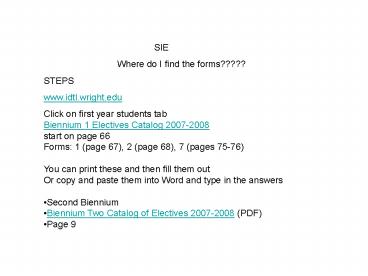SIE - PowerPoint PPT Presentation
1 / 11
Title: SIE
1
- SIE
- Where do I find the forms?????
- STEPS
- www.idtl.wright.edu
- Click on first year students tab
- Biennium 1 Electives Catalog 2007-2008
- start on page 66
- Forms 1 (page 67), 2 (page 68), 7 (pages 75-76)
- You can print these and then fill them out
- Or copy and paste them into Word and type in the
answers - Second Biennium
- Biennium Two Catalog of Electives 2007-2008 (PDF)
- Page 9
2
The main form
- Guidelines for Preparation of Elective Proposals
- In order to facilitate the review of elective
programs, the following standard format is being
employed. - 1. Title - The title of the elective should be
succinct and include not more than 60 letters. It
should be as - specific as possible. For example, "Diagnosis and
Management of Infertility" is more informative
than - "Infertility."
- 2. Department - The department offering the
course must be designated. If the elective is a
conjoint - effort of two departments, or with a non-medical
college of the university, both should be listed.
A - lead department should be designated.
3
- 3. Director Faculty - The director of the
elective should be the individual who has the
major - responsibility for organizing and running the
program, and for evaluating students. All faculty
involved - in presenting the program should be listed, along
with academic rank and affiliation. When - appropriate, guest faculty should be included.
- 4. Time Location - Include under this heading
the number of times a year the elective is
offered, and - the duration. The location(s) must also be
included, e.g., the School of Medicine on campus,
a - particular hospital, or outside the Dayton area.
Also include the lead time required to DROP/ADD
the - elective.
4
- (optional)
- 5. Number of Students - The number of students
which are accepted in the elective each month. - (optional)
- 6. Prerequisites - Prerequisites for a elective
may vary from none to a detailed knowledge of a
specific area. - 7. Course Description - This should be a brief
description, not to exceed two paragraphs.
5
- 8. Content Categories - Specific behavioral
objectives should be listed in terms of what the
student will - be able to do at the end of the elective,
including cognitive knowledge, attitudes, and
skills. - 9. Learning Methods -The methods are an
indication of the precise nature of the learning
experiences - of the elective. For example, will the student
attend lectures or seminars, watch demonstrations
or - examinations, work in the laboratory or on the
wards, or examine specimens or patients. - 10. Evaluation - There should be a delineation of
the specific methods for evaluation of the
student, such - as oral, written and observation, or any
combination. Students will be graded
Honors/Pass/Fail.
6
Example
- NAME OF STUDENT Jessica Hoying
- 1. TITLE Medical Research
- 2. DEPARTMENT Division of Immunobiology
- 3. DIRECTOR/PRECEPTOR Doctor X
- 4. TIME AND LOCATION June 4-July 20 at
Cincinnati Childrens Hospital Medical -
Center, Research Building, Cincinnati, Ohio. -
Minimum contact hours per week will be 35
7
- I skipped s 5 and 6
- Instead I entered a rationale section about why I
wanted to do research as an elective, and how it
would contribute to my medical career
8
- 7. ELECTIVE DESCRIPTION
- The student will be introduced to the conduct of
medical research and procedures through close
observation and participation in laboratory
procedures. - Morning Activities
- Meeting with preceptor and other laboratory
members to plan the days experiments - Weekly lab meeting
- Conduct laboratory experiments
- Afternoon Activities
- Attend seminars
- Continue laboratory experiments
- Analysis of data
- Evening Activities
- Completing reading assignments
- Review of information gained during the daytime
activities
9
- 8. CONTENT CATEGORIES
- The purpose of the SIE is to acquaint the student
with approaches used in exploring medical
research questions and for the student to learn
the theoretical basis and practical application
of specific modern laboratory techniques.
Specifically, the student will gain experience
with - Basic laboratory safety procedures
- Basic experimental study design
- Participating in a research project dealing with
immunological responses in skin epithelial
tissue. Understanding the theoretical basis of
and performing standard molecular biological and
immunological laboratory assays including
RNA/DNA isolation, RT-PCR, Western blotting,
ELISAs, - Statistical analysis of data collected
- Interpretation of laboratory results
10
- 9. SPECIFIC LEARNING METHODS
- 1. Laboratory hands-on training with technical
staff, and post-doctoral - fellows
- 2. Discussion with preceptor
- 3. Literature review of journal articles relevant
to the experiments being - conducted
- 4. Review of laboratory results with preceptor
and other lab members - 5. Analysis and presentation of laboratory
results - 6. Attendance at laboratory meetings
- 7. Attendance at Immunology Seminar Series
11
- 10. EVALUATION
- The following indices will be evaluated and
summarized on the WSU/SOM preceptor evaluation
form for SIE at the completion of the elective - 1. Observation of student in laboratory setting
- 2. Oral discussion with preceptor
- 3. Critique of laboratory data notebook and
abstract of experimental results - 4. Critique of oral presentation of the results
of the laboratory experiments to the - group at an organized lab meeting
- 5. Completion of WSU/SOM preceptor evaluation
form for clinical experience - SIE
- 6. Student log of the elective experience to be
submitted and reviewed at the - completion of the elective by a member of
the Biennium One Electives - Subcommittee































